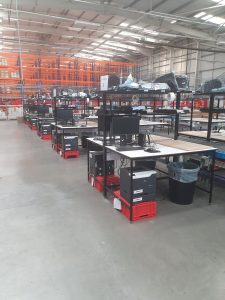Your basket is currently empty!

Peak season has rolled around again, and it’s nearly time to up the pace. Your warehouse will soon be subject to more orders, and deadlines will be closing in.
So what can you do to prepare for the annual rush?
This article includes four top tips to help you stay ahead of, rather than behind, demand.
Optimise layout and workflow
An organised warehouse is an efficient warehouse. Small improvements to your layout and workflow can save you seconds – and that time adds up.
First, reslotting your inventory – that is, reorganising and rearranging items to make them more easily accessible and nearer to packing or shipping stations – is a good first port of call. Group similar products together and ensure that the most frequently picked stock keeping units (SKUs) are stored at waist height. This not only speeds things up but also reduces congestion around the warehouse.
Flow – how orders are processed from receiving to shipping – is another opportunity for improvement. Look to make changes to aisle layouts and pick paths that reduce bottlenecks and any movement that is unnecessary.
Then there is capacity. Increasing capacity – if you can – is an excellent way of giving your storage facility more breathing space during peak season, while also avoiding safety risks and upping accessibility. Consider installing temporary shelving and taller racks to make the most of your vertical space.
Train and staff your team
People are your prized asset, and a capable workforce is key to meeting peak season demands. Ask yourself whether you could benefit from temporary hires, and whether your existing team is properly trained to handle the rush.
Training your team early helps. They should have had some time working with new systems or safety protocols and learning about procedures that are specific to peak season. Utilise cross-training, which allows employees to switch roles when needed.
If you plan to bring in temporary workers, start the hiring process early. Provide guidance and shadowing opportunities so they can learn your processes quickly. Well-trained ‘temps’ can give your operations a huge boost across the board.
Communication is key, and when you are working around the clock, teams need to relay important information across shifts. How well is your existing infrastructure set up? Would adding daily huddles, digital message boards, or two-way radios to the communication mix make a difference during these busy times?
Going back to shifts, you’ll need to schedule working hours smartly to reduce burnout and also avoid congestion on the warehouse floor.
Leverage technology and equipment
Is it time to review your warehouse management systems (WMS)? If they aren’t popular with staff for picking, packing and inventory tracking, it could be time to think about a more effective alternative before peak season. If your WMS doesn’t do this already, you may want to try a system with an analytics aspect, so you can use data for forecasting and identifying inefficiencies.
Are you making the most of available equipment to reduce packing time? The best automated tapers, weigh scales and label printers that you can purchase within your budget can help to speed up processing.
When it comes to equipment such as forklifts, conveyors, scanners and packing machines, schedule preventative maintenance before demand spikes.
Manage inventory and space
As we have already touched upon, an organised inventory and intelligent use of space can be ‘make or break’ when your warehouse is packed with items. Ahead of time, have a declutter and deep clean. This can involve removing obsolete stock and damaged items, and the cleaning and sanitisation of floors, racks and workstations. A tidy environment is a better workplace for all and reduces accident risk.
Perform inventory audits to verify stock accuracy and identify discrepancies early. You should also have a plan for tackling that inevitable feature of peak season – returns. Consider a dedicated space for returned goods, and review your inspection and restocking procedures, making sure you can process returns as fast as possible.
Ahead of peak season, give yourself some time to think things through. How can you achieve easy warehouse wins that will result in a more productive and less stressful time over the coming months? We hope the tips above will help.
You may also interested in:

How to avoid manual handling accidents with vans
Warehouses where items are loaded into vans can pose a risk of
New report highlights limitations of automating the warehouse
A new report by Prological on the future of warehouses examines the issue of automation. It notes that
